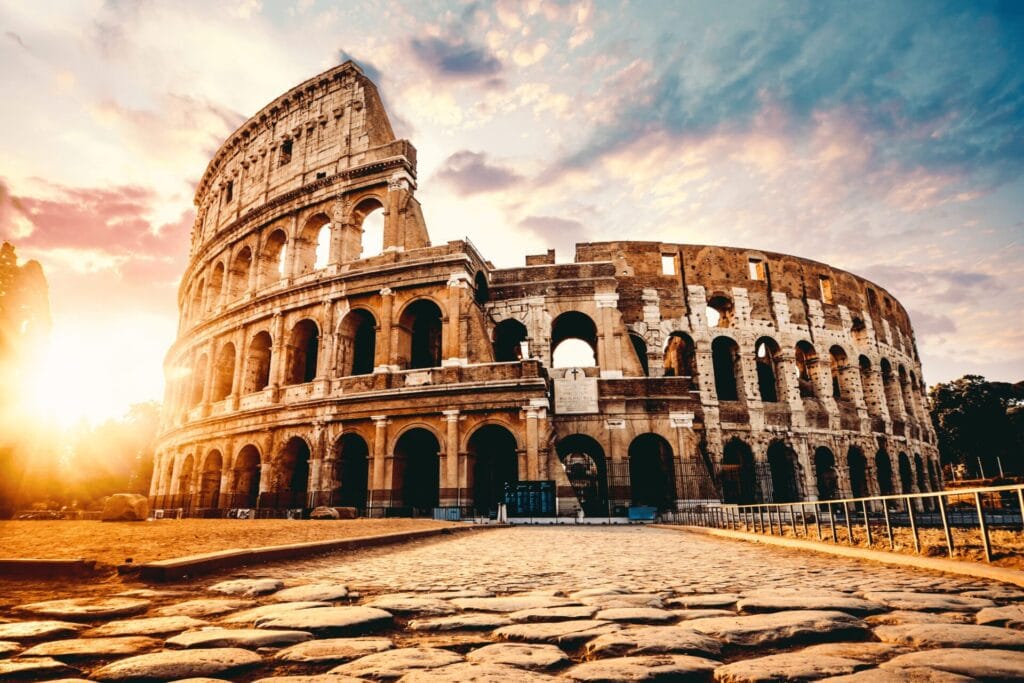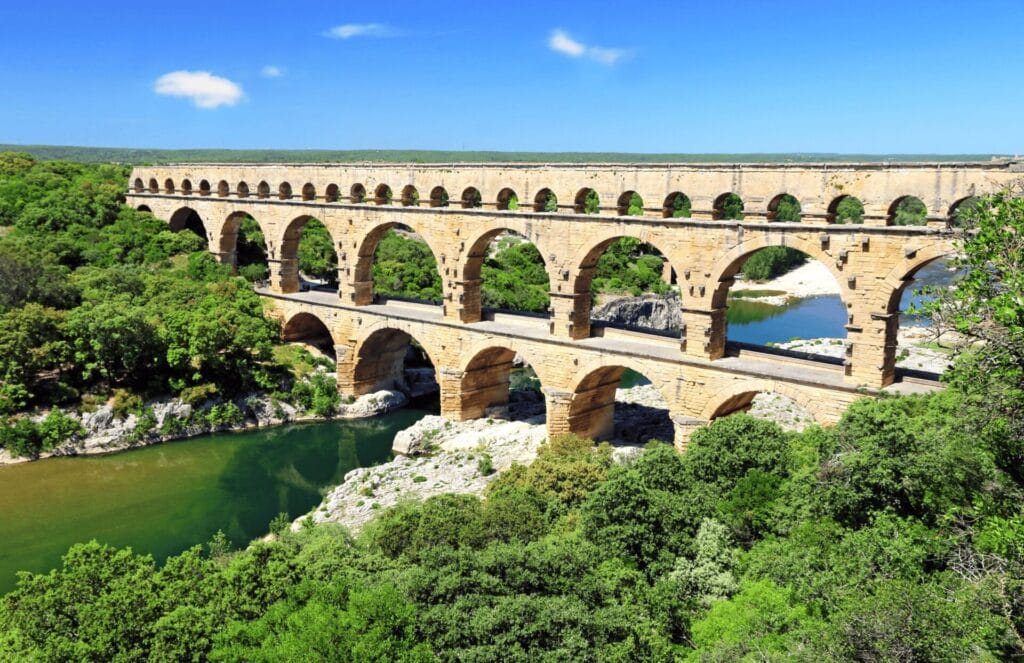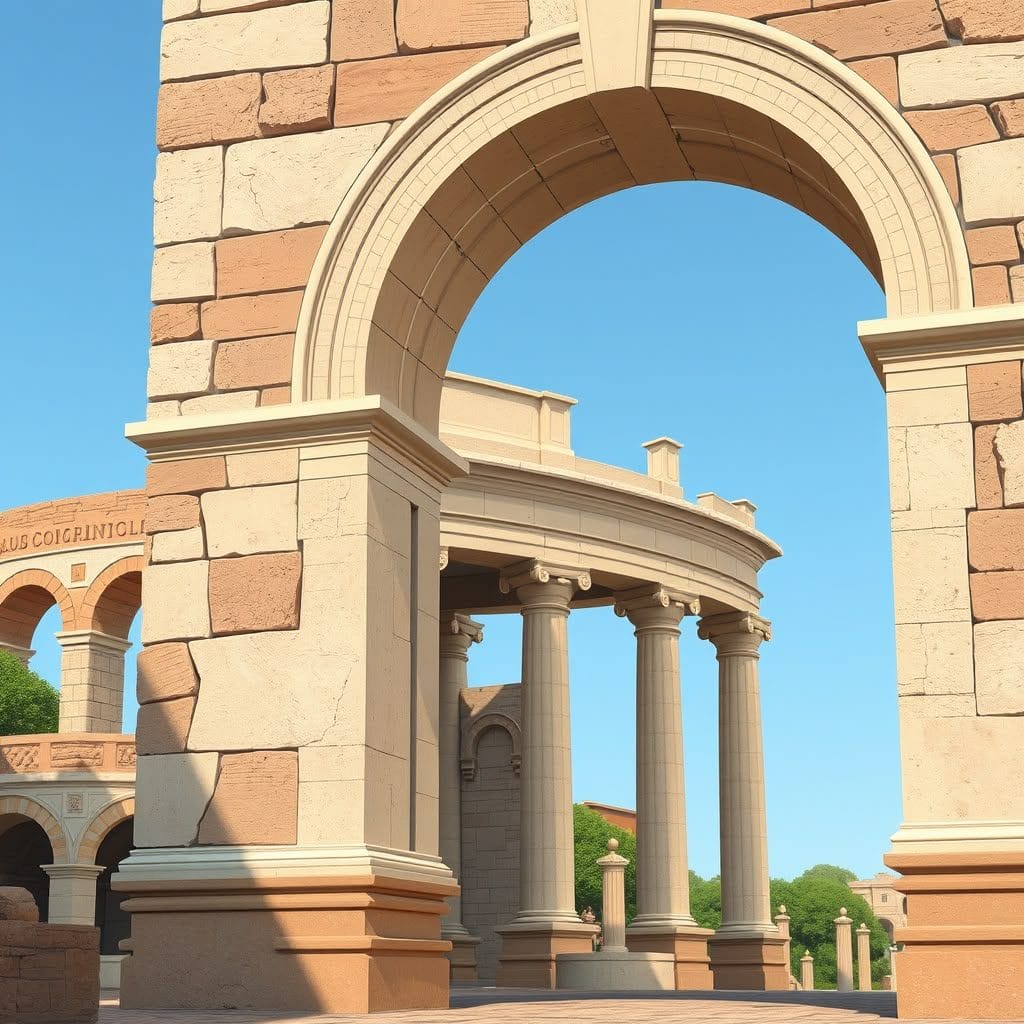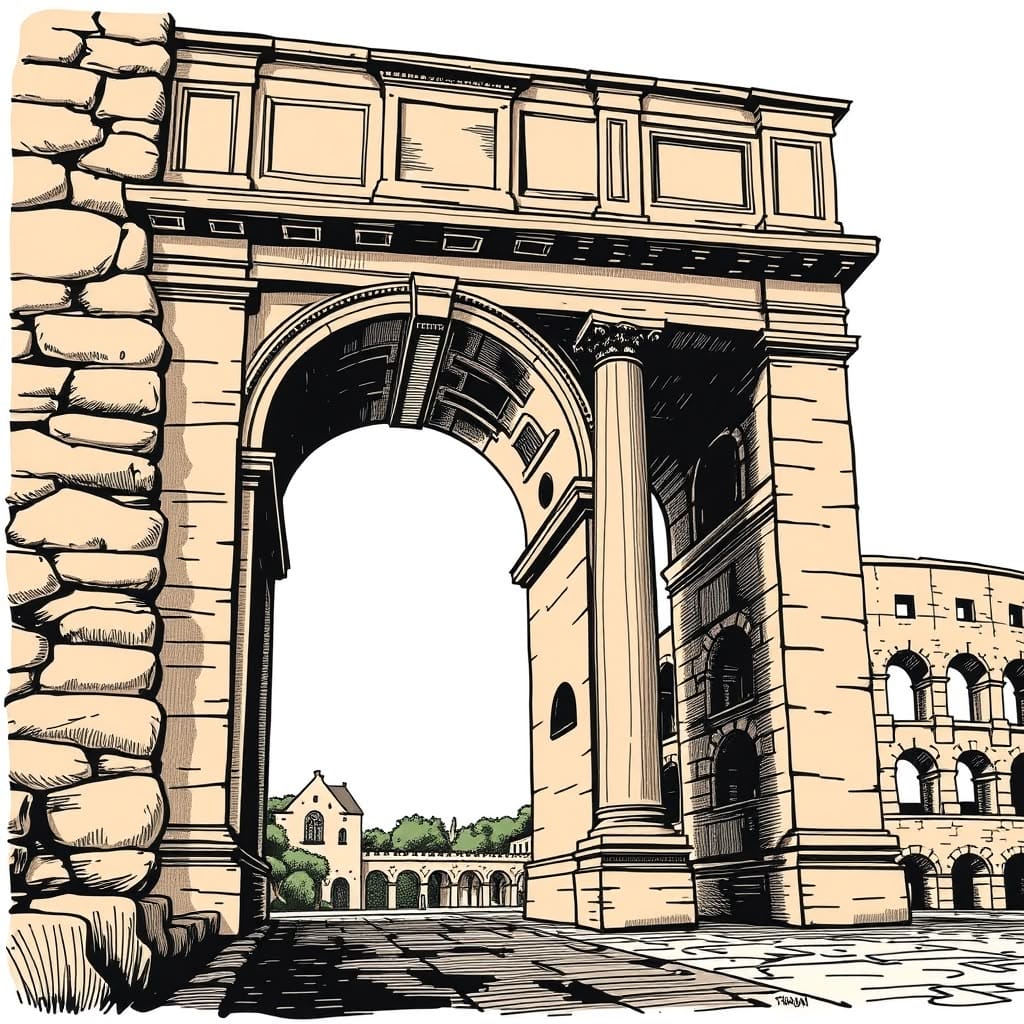Roman architecture is a remarkable blend of engineering and artistic skill. Known for its grandeur and creativity, it has influenced countless structures we see today. One of the key elements that define Roman design is the arch, which not only adds strength but also beauty to their creations.
The Origins and Evolution of the Arch
The arch is a fundamental element of Roman architecture, but its origins can be traced back to Etruscan architecture. The Etruscans, who lived in Italy before Rome became powerful, were skilled builders. They used the arch in their constructions, which was a significant improvement over the earlier civilizations’ use of flat beams (post-and-lintel) for support.
Early Use of the Arch by Etruscans
The Etruscans employed a basic form of the arch called the corbel arch, where stones were arranged in a stepped manner to create a curved shape. This technique allowed for larger openings in walls and ceilings. Additionally, the design enabled better weight distribution compared to flat roofs, reducing stress on supporting walls. It also opened up possibilities for creating spacious interiors in temples and public buildings.
Roman Innovations
The Romans learned from the Etruscans and made several important improvements to the arch:
- True Arch Construction: Unlike the corbel arch used by Etruscans, the Romans developed the true arch, which uses a keystone at its highest point. This design distributes weight more effectively across the structure.
- Materials and Engineering: The incorporation of concrete allowed for greater flexibility and strength. Romans could create larger spans without compromising stability.
- Standardization: Romans standardized various arch dimensions, leading to uniformity in construction practices across their vast empire.

Architectural Techniques Employed
The evolution of the arch included various architectural techniques that contributed to its effectiveness:
- Segmental Arches: These arches have a less-than-semi-circular shape, allowing for lower profile designs while maintaining structural integrity.
- Arcades: Rows of arches supported by columns became prominent features in public spaces like forums and basilicas. This not only enhanced structural support but also added aesthetic appeal.
- Vaults and Domes: Arches formed the basis for developing vaults and domes, enabling architects to create expansive interior spaces without relying solely on columns.
Impact on Roman Structures
The mastery of the arch facilitated monumental constructions throughout Rome:
- Aqueducts: Structures like the Pont du Gard exemplify how arches were employed to transport water over great distances.
- Bridges: Roman bridges utilized arches to span rivers and ravines efficiently while adding visual grandeur.
- Amphitheaters: Buildings such as the Colosseum showcased intricate systems of arches that provided not just structural support but also impressive sightlines for spectators.
The transition from Etruscan usage of arches to Roman innovation is a testament to human ingenuity in architecture. Roman engineers and architects built upon early techniques, mastering the arch to create enduring structures that continue to inspire modern design. This historical development highlights not just an architectural achievement but also a cultural movement toward sophistication in building practices that defined an era.

The Importance of Arches in Roman Architecture
The arch is a significant innovation in Roman architecture, changing the way large structures were designed and built. This architectural wonder enabled the Romans to expand the limits of engineering, resulting in buildings that were not only more impressive but also longer-lasting.
Benefits of Using Arches
The introduction of arches brought several important advantages:
- Even Distribution of Weight: Arches distribute weight evenly across their curve, reducing pressure on individual parts of a structure. This feature allowed builders to create larger openings without using excessive materials.
- Enhanced Stability: The design of arches improves stability, making it possible to construct taller and wider buildings. This capability was crucial for creating spacious areas in public structures and arenas.
- Efficient Use of Materials: By incorporating arches, the Romans were able to use less material while achieving greater strength. This efficiency was especially important in large-scale projects like aqueducts and bridges.

Iconic Roman Structures Made Possible by Arches
Arches played a vital role in the construction of several famous Roman structures, each showcasing unique engineering achievements:
Aqueducts
Roman aqueducts are known for their impressive size and functionality. These structures transported water over long distances, often crossing valleys and hills through a series of arches.
- Pont du Gard: A prime example of Roman ingenuity, the Pont du Gard is an aqueduct bridge featuring three tiers of arches. Its design allowed it to carry water from a distant spring, demonstrating both aesthetic appeal and practical utility.
- Efficiency in Design: The multi-tiered arches not only elevated the water channel but also minimized resistance from gravity, showcasing how Romans mastered both form and function.
Bridges
Roman bridges often used arches to navigate difficult landscapes.
- Ponte Fabricio: Built in 62 BC, this bridge exemplifies the strength provided by its arch-based design. It has withstood centuries of use while maintaining its structural integrity.
- Innovative Techniques: By employing a series of arches, bridges could span wider gaps than previously possible. This innovation helped connect various regions across the empire, facilitating trade and communication.

Amphitheaters
The Colosseum stands as one of the most famous examples where arches were instrumental in creating vast entertainment venues.
- Colosseum’s Arched Facade: The exterior features nearly 80 arches on each level, supporting massive stone blocks while providing entrances for spectators. This ingenious design showcases how arches enhance both durability and accessibility.
- Interior Design Advantages: Inside the Colosseum, arches played a crucial role in supporting large crowds during events. The structural framework allowed for tiered seating arrangements without compromising stability.
The Impact of Arches on Construction Methods
The incorporation of arches into Roman architecture marked a significant turning point that transformed construction techniques. Their ability to support larger openings led to groundbreaking advancements in building designs that prioritized both functionality and visual impact.

Examining Iconic Examples: The Colosseum and The Pont du Gard
The architectural legacy of Roman innovation is vividly illustrated through two of its most iconic structures: the Colosseum and the Pont du Gard. Both exemplify how mastering the arch transformed not only construction techniques but also the aesthetic and functional dimensions of architecture.

The Colosseum: A Marvel of Engineering
The Colosseum, completed in 80 AD, serves as a testament to Rome’s architectural prowess. Its design incorporates multiple levels of arches, each contributing to both structural integrity and visual grandeur. Key elements include:
- Series of Arches: The façade features approximately 80 arches on each level, allowing for seamless entry while distributing weight evenly across the massive structure.
- Innovative Use of Space: The arches support a complex system of vaults that create large open areas within, facilitating crowds of up to 50,000 spectators.
- Aesthetic Appeal: The rhythmic pattern created by the arches enhances the beauty of the structure, making it an iconic symbol of Roman engineering.
The arches are not merely functional; they embody a harmonious blend of form and purpose. They elevate the Colosseum above just a venue for entertainment into an enduring symbol of Roman culture.

The Pont du Gard: A Testament to Practicality and Elegance
Constructed in the first century AD to transport water from Uzes to Nîmes in France, the Pont du Gard stands as another remarkable example of Roman ingenuity. Its three-tiered structure showcases:
- Multiple Arches: Comprising 35 arches across three levels, this aqueduct demonstrates how Roman engineering solved practical challenges while maintaining aesthetic appeal.
- Height and Span: At nearly 50 meters high, its tallest tier allows for a gradual slope that ensures water flow over long distances without disruption.
- Symmetrical Design: Each arch is meticulously crafted, emphasizing balance and proportion that contribute to its majestic appearance.
The Pont du Gard exemplifies how functionality can coexist with artistic expression. It serves both as a critical infrastructure element and an architectural landmark that has inspired countless modern designs.

Influence on Modern Architecture
The principles established by these iconic structures extend far beyond their own time. Contemporary architects frequently draw upon Roman techniques, especially when designing bridges and public buildings. Examples include:
- Modern Bridges: Many contemporary designs incorporate arches for efficient weight distribution, mirroring techniques seen in the Pont du Gard.
- Public Buildings: Architectural styles featuring arched windows and doorways reflect the aesthetic legacies initiated by structures like the Colosseum.
In both cases, you see how mastering the arch not only enabled larger and more durable constructions but also left an indelible mark on modern architecture. The influence persists in various forms—bridges that span wide rivers or buildings that inspire awe—all trace back to those fundamental innovations pioneered by Roman engineers.
Through studying these iconic examples, you gain insight into how Romans used architecture as a means to convey power, innovation, and resilience—qualities that resonate even today.

Aesthetic Appeal vs. Practical Functionality: Understanding the Duality of Arches in Roman Architecture
The Roman arch is a prime example of how beauty in architecture can coexist with functional design. This duality is evident in various structures throughout ancient Rome, where arches served both as structural supports and as visual statements.
Balancing Form and Function
- Structural Integrity: The design of arches allows for the efficient distribution of weight. This engineering principle enabled Romans to create expansive spaces without compromising stability. For instance, the Colosseum’s numerous arches not only support the massive structure but also enhance its aesthetic grandeur.
- Design Elegance: The curvature of arches adds a sense of elegance to buildings. This beauty is not merely decorative; it enhances the viewer’s experience while maintaining the necessary functionality. When observing structures like the Pont du Gard, one can appreciate how the layered tiers of arches create a visually striking silhouette against the landscape while effectively transporting water over great distances.
Demonstrating Practical and Aesthetic Uses
- Aqueducts and Bridges: Roman engineers displayed remarkable ingenuity by incorporating arches into utilitarian structures such as aqueducts and bridges. These constructions reveal how functionality does not preclude beauty. The Pont du Gard exemplifies this, showcasing a harmonious blend of practical engineering with an impressive aesthetic that has inspired generations.
- Amphitheaters and Public Buildings: In public spaces like amphitheaters, arches contributed to both acoustics and crowd flow. The Colosseum utilized its arcades to facilitate movement while allowing spectators to enjoy unobstructed views of performances. This dual purpose highlights how Romans prioritized user experience alongside structural requirements.
Influence on Modern Design
The principles established by Roman architects continue to influence contemporary design. Modern bridges and buildings frequently employ arch designs for their ability to combine strength with visual appeal.
- Modern Applications: Today’s architects draw inspiration from Roman techniques, creating structures that prioritize both aesthetic value and functionality. Examples include:
- Brooklyn Bridge: Incorporates large stone arches that contribute to its iconic skyline presence while ensuring stability.
- St. Louis Gateway Arch: A modern tribute to the arch concept, blending function as a monument with striking aesthetics.
- Sustainability in Design: Just as Romans embraced materials like concrete and stone for durability, modern designs often integrate sustainable practices while retaining arch aesthetics. This connection reveals an enduring legacy where form and function continue to thrive together.
The mastery demonstrated by Roman architects in using arches showcases a vital intersection of art and engineering, revealing how these ancient innovations laid a foundation for future architectural endeavors that value both beauty and practicality in design.

The Lasting Impact of Roman Arches on Modern Architecture
The principles of the Roman arch have transcended time, continuing to influence contemporary design principles in various architectural realms. Modern architects and engineers draw from the ingenious designs pioneered by the Romans, integrating these elements into today’s constructions.
Key Integrations of Roman Arch Principles
1. Bridges
Many modern bridges utilize arches as a primary structural element. This design choice is not merely aesthetic; it offers significant advantages in weight distribution and load-bearing capacity.
- Examples include the Sydney Harbour Bridge and the Ponte Vecchio in Florence, both designed with arches that enhance stability while providing striking visual appeal.
2. Buildings
In urban architecture, arches are often incorporated into facades and entrances, serving as both functional and decorative features.
- The use of arches allows for larger openings without compromising structural integrity, evident in structures like the Louvre Pyramid in Paris, which harmonizes modern glass design with classical arch forms.
3. Aqueducts
Contemporary water transport systems take cues from the engineering feats of ancient Rome. While modern materials differ, the fundamental principle of using arches to span distances remains relevant.
- Projects like the Los Angeles Aqueduct showcase how modern engineers replicate arch designs to manage water flow over varying terrains efficiently.

Legacy of Roman Engineering in Modern Structures
The legacy of Roman engineering is visible not only in specific structures but also in broader architectural philosophies:
1. Strength and Durability
Buildings constructed with arched frameworks exhibit enhanced resilience against natural forces. This has made arches a preferred choice in earthquake-prone regions where flexibility combined with strength is crucial.
- The innovative use of reinforced concrete has further allowed architects to explore expansive arched designs while maintaining safety.
2. Sustainability
Modern architects are increasingly focused on sustainable practices. The efficient use of space created by arches contributes to energy savings through natural lighting and ventilation strategies.
- Structures such as the Eden Project in Cornwall demonstrate how arched geodesic domes can create microclimates while relying on minimal material use.
Aesthetic Inspirations
The aesthetic qualities intrinsic to Roman arches continue to resonate within contemporary architecture:
1. Visual Harmony
Arches contribute to a sense of balance and proportion, which remains a key consideration for architects today. They enhance public spaces by creating inviting entry points that encourage interaction.
- Notable examples include the Gateway Arch in St. Louis, which symbolizes both a historical context and an artistic expression rooted in arch design.
2. Cultural References
Incorporating arch elements serves as a nod to historical significance, allowing contemporary buildings to connect with their cultural heritage.
- Structures like the National Gallery of Art in Washington D.C. evoke classical influences through their arched porticos while standing firmly within modern contexts.
As you explore architectural landscapes today, it becomes evident that mastering the Roman arch was not merely a historical achievement; it laid foundational principles that continue to shape our built environment. Through bridges, buildings, aqueducts, and aesthetic expressions, Roman innovations endure as vital components influencing modern architectural practice across diverse applications.

Conclusion
Mastering the arch was crucial for Roman architectural innovation, with significant effects that reach into modern design. The importance of the arch can be summarized in several key points:
- Origins and Perfection: The arch has its origins in Etruscan architecture. Romans improved this method, taking it to new levels of structural strength and visual appeal.
- Structural Advancements: Arches made it possible to build larger and more long-lasting structures. Buildings like aqueducts, bridges, and amphitheaters became possible because of the arch’s ability to evenly distribute weight. This engineering wonder allowed Romans to go beyond the usual limits of their time.
- Iconic Examples: The Colosseum stands as a testament to the effectiveness of arches in supporting massive structures while enhancing visual impact. Similarly, the Pont du Gard exemplifies how arches serve both functional and decorative roles, showcasing elegance in engineering.
- Enduring Influence: The principles established by Roman architects remain relevant today. Modern bridge designs frequently incorporate arches for strength, while many buildings draw inspiration from this ancient innovation.
The lasting impact of Roman arches on contemporary architecture cannot be overstated. As architects continue to explore new possibilities for design and functionality, the legacy of mastering the arch serves as a guiding light. Understanding these fundamentals not only enriches our appreciation for historical innovations but also inspires future perspectives on architecture. The mastery of the arch transformed Roman society and continues to shape our built environment today, reminding us of the timeless interplay between form and function.

FAQs (Frequently Asked Questions)
What is the significance of the arch in Roman architecture?
The arch is a fundamental element in Roman architecture, allowing for the construction of larger and more durable structures such as aqueducts, bridges, and amphitheaters. Its design not only enhanced structural integrity but also contributed to the aesthetic appeal of monumental buildings.
How did the Romans innovate upon the Etruscan arch?
The Romans perfected the arch originally developed by the Etruscans by enhancing its engineering techniques. They utilized new materials and construction methods, which allowed for greater spans and more complex structures, thus revolutionizing architectural design.
Can you provide examples of famous Roman structures that utilize arches?
Notable examples include the Pont du Gard, an impressive aqueduct bridge, and the Colosseum, an iconic amphitheater. Both structures showcase the practical and aesthetic applications of arches in Roman architecture.
What role do arches play in balancing aesthetics and functionality?
Arches in Roman architecture exemplify a balance between beauty and functional design. They not only serve critical structural purposes by distributing weight effectively but also enhance the visual appeal of buildings through their elegant forms.
How have Roman arch principles influenced modern architecture?
The principles behind Roman arches continue to be integrated into contemporary designs. Modern bridges and buildings often employ similar arch techniques to achieve both strength and beauty, reflecting the enduring legacy of Roman engineering.
What impact did mastering the arch have on future architectural innovations?
Mastering the arch significantly shaped Roman architectural innovation by enabling larger constructions that were previously impossible. This mastery laid foundational principles that influenced subsequent architectural styles and practices throughout history.

